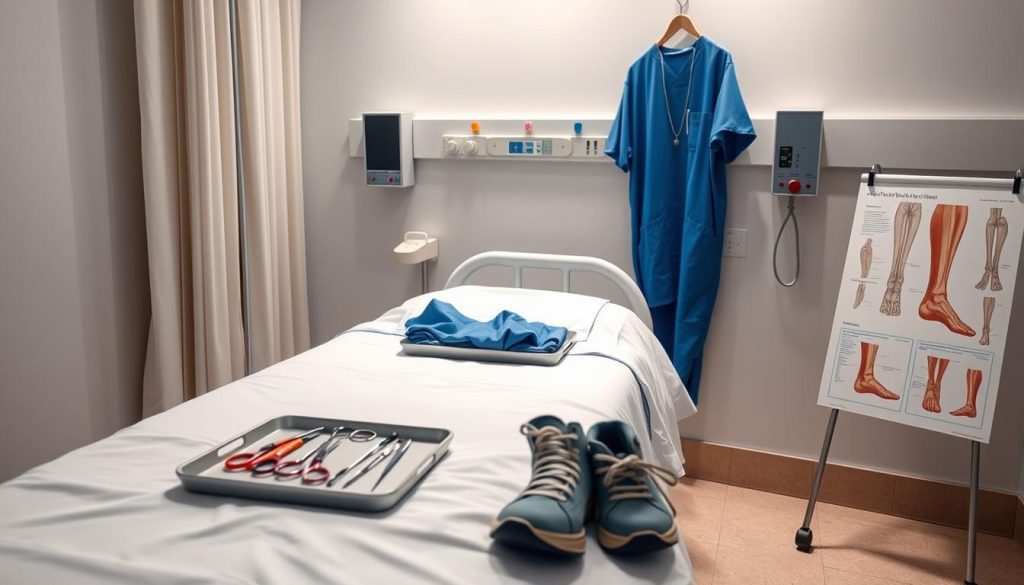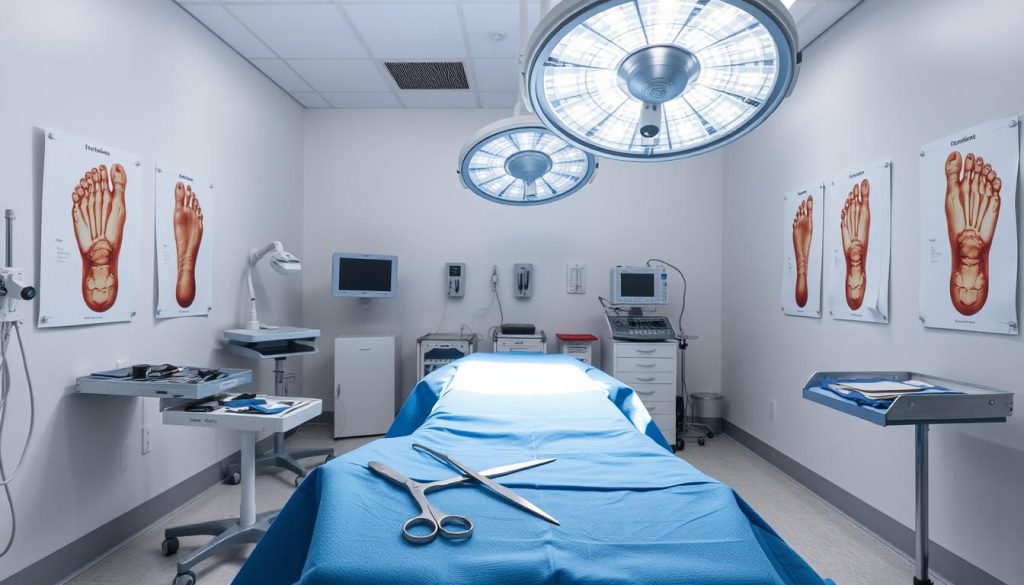Foot surgery can seem scary for many. This guide aims to clear up the confusion. It covers common surgeries, recovery times, and treatment choices. Knowing about bunion removal or hammertoe correction is vital for a good outcome.
We’ll cover everything from getting ready for surgery to caring for your feet after. Our aim is to give you the info you need to make smart choices about your foot health. By looking at different parts of foot surgery, we hope to ease your worries and set clear recovery goals.
Let’s explore the world of podiatric procedures together. Modern surgical methods are changing how patients feel. With expert tips and practical advice, you’ll be ready to move towards healthier, pain-free feet.
Understanding Common Types of Foot Surgery
Foot surgery can fix many painful conditions. This affects how well you can move and enjoy life. Let’s look at three common surgeries podiatrists do to solve foot problems.
Bunion Surgery Procedures
Bunion surgery aims to fix the big toe’s alignment and ease pain. Doctors might remove the bony bump, adjust the joint, or fuse bones. It takes 6-8 weeks to recover, and full healing takes 4-6 months.

Hammertoe Correction Methods
Hammertoe surgery fixes bent toes that hurt. Doctors use tendon transfer, joint removal, or fusion. Most people can go back to normal activities in 6-8 weeks after surgery.
Plantar Fasciitis Surgical Options
If other treatments don’t work, surgery for plantar fasciitis might be needed. This includes releasing the plantar fascia or doing a gastrocnemius recession. Recovery time is usually 6-10 weeks.
| Surgery Type | Average Recovery Time | Success Rate |
|---|---|---|
| Bunion Surgery | 6-8 weeks | 85-90% |
| Hammertoe Surgery | 6-8 weeks | 80-85% |
| Plantar Fasciitis Surgery | 6-10 weeks | 75-80% |
Each surgery needs careful thought and a talk with a skilled podiatrist. They help decide the best surgery for each person.
When Is Foot Surgery Necessary?
Foot surgery is needed when other treatments don’t work. People often wonder when it’s time to think about surgery for their foot issues. Let’s look at what makes surgery a good choice.
Pain and how long it lasts are key in deciding on surgery. If pain lasts months and treatments don’t help, surgery might be needed. Also, if you can’t move as you should, it’s a sign.
How a foot condition changes is also important. If it gets worse or causes more problems, surgery might be the best option. For example, big bunions or hammertoes that don’t get better with other treatments usually need surgery.
- Persistent pain unresponsive to non-surgical treatments
- Significant limitation in mobility and daily activities
- Progressive deformities causing secondary problems
- Reduced quality of life due to foot issues
How much your life is affected by your foot is also a big factor. If your foot problems make it hard to work, exercise, or enjoy life, surgery might help a lot.
“Foot surgery should be considered when conservative treatments have been exhausted and the patient’s quality of life is significantly impacted by their foot condition.”
| Condition | Conservative Treatment | Surgical Indication |
|---|---|---|
| Bunions | Orthotics, wider shoes | Severe pain, difficulty walking |
| Plantar Fasciitis | Stretching, night splints | Chronic pain after 6-12 months of treatment |
| Hammertoes | Toe exercises, padding | Rigid deformity, open sores |
Seeing a foot specialist is important to know if you need surgery. They will check your condition, think about all options, and suggest surgery only when it’s the best choice for long-term relief and better foot function.
Preparing for Your Surgical Procedure
Getting ready for foot surgery, like Achilles tendon surgery, is very important. Knowing what to expect and how to prepare can help you feel less anxious. It can also make your surgery more successful.
Medical Evaluations and Tests
You’ll have to go through several medical checks before your surgery. These might include blood tests, X-rays, MRIs, and a physical exam. For Achilles tendon surgery, an ultrasound might be needed to check the tendon’s health.
Lifestyle Adjustments Before Surgery
Changing your lifestyle is key for the best results after surgery. You might need to:
- Stop smoking to help your body heal faster
- Change your medications, like blood thinners
- Eat a special diet to support your recovery
- Plan for someone to take care of you after surgery

What to Pack for Hospital Stay
When you go to the hospital, bring important items like:
- Comfortable, loose clothes
- Non-slip shoes or slippers
- Personal hygiene items
- Important documents, like ID and insurance
- All your current medications
Good preparation is very important for recovering well after foot or Achilles tendon surgery. Always listen to your surgeon’s advice for the best outcome.
Modern Surgical Techniques in Podiatry
Podiatric surgery has seen big changes in recent years. New tech and fresh methods have changed how doctors treat foot and ankle issues. These new ways lead to better results and quicker healing for patients.
Computer-assisted surgery is a big leap forward in ankle surgery. It lets surgeons plan and do surgeries with great accuracy. 3D imaging makes detailed maps of the patient’s foot, helping the surgeon during the operation.
3D printing for custom implants is another exciting thing. Surgeons can now make implants that fit each patient perfectly. This personal touch leads to better results and fewer problems in ankle surgery.
Advanced imaging has also changed surgery a lot. High-resolution MRI and CT scans give surgeons clear views of soft tissues and bones. This helps in diagnosing and planning treatments for complex foot and ankle issues.
| Technique | Benefits | Applications |
|---|---|---|
| Computer-Assisted Surgery | Increased precision, reduced errors | Complex ankle reconstructions |
| 3D Printed Implants | Custom fit, improved outcomes | Ankle joint replacements |
| Advanced Imaging | Better diagnosis, targeted treatment | Soft tissue injuries, bone deformities |
These modern methods have opened up new chances in ankle surgery. Patients now get less invasive surgeries, heal faster, and see better long-term results. As tech keeps getting better, the future of podiatric surgery looks very promising.
The Role of Minimally Invasive Foot Surgery
Minimally invasive foot surgery is changing podiatric care. It uses small incisions and special tools to treat foot issues with less damage. Many patients like it because of its benefits.
Benefits of Arthroscopic Procedures
Arthroscopic surgeries have many advantages over traditional open surgeries:
- Smaller incisions
- Reduced scarring
- Less post-operative pain
- Quicker return to daily activities
These procedures work well for metatarsal surgery. They allow surgeons to be precise. Patients often see less swelling and a lower risk of infection.
Recovery Time Comparisons
Recovery times differ between minimally invasive and traditional surgeries:
| Procedure Type | Minimally Invasive | Traditional |
|---|---|---|
| Bunion Correction | 2-4 weeks | 6-8 weeks |
| Metatarsal Surgery | 3-5 weeks | 6-10 weeks |
| Hammertoe Repair | 2-3 weeks | 4-6 weeks |
Minimally invasive techniques can lead to faster recovery. But, they might not be right for all foot issues. It’s important to talk to a skilled podiatric surgeon to find the best option.
Post-Operative Care and Recovery Timeline
After foot surgery, it’s important to take good care of yourself. The healing time can vary, but most follow a similar path. Knowing this timeline helps you get ready for your recovery journey.
Right after surgery, managing pain is the main focus. Your doctor will give you medicine to help with this. It’s also key to keep the surgical area clean and dry, as your surgeon will tell you.
The first weeks are all about resting and keeping your foot up. This is when your body starts to heal. You might need to use crutches or a knee scooter to avoid putting weight on your foot. Swelling is normal, so make sure to keep your foot above your heart when you’re sitting or lying down.
| Recovery Phase | Duration | Key Activities |
|---|---|---|
| Initial Recovery | 1-2 weeks | Rest, elevation, pain management |
| Early Healing | 3-6 weeks | Limited weight-bearing, wound care |
| Progressive Mobility | 6-12 weeks | Increased activity, physical therapy |
As you get better, your surgeon will tell you when you can start putting more weight on your foot. Physical therapy usually starts around 6-8 weeks after surgery. It helps you regain strength and flexibility. It can take several months to fully recover from foot surgery, but most people see big improvements in 3-4 months.
“Patience is key in foot surgery recovery. Each step forward, no matter how small, is progress towards your goal of full mobility.”
Managing Pain and Discomfort After Surgery
Managing pain after foot surgery is key for a smooth recovery. Proper pain control helps you heal faster and regain mobility. Let’s explore effective ways to handle post-operative discomfort.
Medication Management
Your doctor will prescribe pain medications tailored to your needs. Follow the dosage instructions carefully. Some common pain relief options include:
- Opioids for severe pain
- Non-steroidal anti-inflammatory drugs (NSAIDs)
- Acetaminophen for mild discomfort
Keep track of your medication schedule to ensure consistent pain relief.
Natural Pain Relief Methods
Complement your medication with these natural techniques:
- Ice therapy to reduce swelling
- Elevation to improve circulation
- Gentle foot exercises as advised by your surgeon
When to Contact Your Doctor
While some discomfort is normal, certain symptoms warrant immediate medical attention:
- Severe, uncontrolled pain
- Signs of infection (fever, redness, warmth)
- Numbness or tingling in the foot
Don’t hesitate to call your doctor if you’re unsure about your symptoms.
In some cases, a neurectomy may be part of your foot surgery. This procedure involves removing a portion of a nerve to alleviate chronic pain. If you’ve undergone a neurectomy, follow your surgeon’s specific post-operative instructions for optimal recovery and pain management.
| Pain Level | Recommended Action |
|---|---|
| Mild (1-3) | Over-the-counter pain relievers, ice, elevation |
| Moderate (4-6) | Prescribed medications, rest, gentle exercises |
| Severe (7-10) | Contact your doctor immediately |
Physical Therapy and Rehabilitation Exercises
After foot surgery, physical therapy is key to your recovery. It helps bring back strength, flexibility, and function to your foot. A good rehabilitation plan can make your healing faster and improve your long-term results.
Your physical therapist will show you exercises made just for your surgery. These might include:
- Range of motion exercises to improve flexibility
- Strength training to rebuild muscle power
- Gait training to help you walk properly
- Balance exercises to prevent falls
As you get better, your exercises will get harder and more complex. This careful increase helps you recover safely and effectively from your surgery.
“Consistent participation in physical therapy is key to achieving optimal results after foot surgery.”
It’s very important to stick with your rehabilitation plan. Listen to your therapist and do your exercises as they say. Being dedicated can help you heal faster and keep your foot working well in the long run.
| Rehabilitation Phase | Focus Areas | Duration (Weeks) |
|---|---|---|
| Early | Pain management, gentle range of motion | 1-2 |
| Intermediate | Strengthening, weight-bearing exercises | 3-6 |
| Advanced | Sport-specific training, full function restoration | 7-12 |
Every foot surgery is different. Your rehabilitation plan will be made just for you. Stay hopeful and patient, and you’ll get the best results.
Potential Complications and Risk Factors
Foot surgery, like any medical procedure, carries risks. Understanding these risks helps patients make informed decisions. It also helps them take proactive steps for a successful recovery.
Common Complications
Post-operative infections are a major concern. Bleeding, blood clots, and nerve damage can also occur. In rare cases, patients may have adverse reactions to anesthesia. Some surgeries, like arthrodesis, might lead to joint stiffness or improper bone fusion.
Prevention Strategies
Patients play a key role in minimizing risks. Here are some tips:
- Keep the surgical site clean and dry
- Take prescribed medications as directed
- Attend all follow-up appointments
- Avoid smoking, which can hinder healing
- Maintain a healthy diet to support recovery
Risk Management
Surgeons use various techniques to manage risks. These include:
| Technique | Purpose |
|---|---|
| Pre-operative screening | Identify any health issues |
| Sterile operating environment | Reduce infection risk |
| Antibiotic prophylaxis | Prevent post-operative infections |
| Careful surgical planning | Minimize tissue damage |
By working closely with your healthcare team and following their guidance, you can reduce complications. This ensures a smoother recovery from foot surgery.
Advanced Treatment Options for Complex Foot Conditions
Complex foot conditions need special surgery. New methods and tools have changed how we treat severe problems. This includes failed surgeries and many foot issues at once.
Joint replacement, or arthroplasty, is a new way to help those with severe arthritis or damaged joints. It replaces the bad parts with artificial ones. This makes the joint work better and hurts less.
Complex surgeries fix severe deformities or many foot problems at once. These might include bone grafts, tendon transfers, or fixing joints. They help make the foot work right again.
External fixation devices are key for complex foot issues. These frames, attached to bones through the skin, help fix deformities slowly. They also keep the foot stable while it heals.
- 3D-printed implants for custom joint replacements
- Computer-assisted surgery for precise bone cuts and implant placement
- Biological augmentation techniques using growth factors to enhance healing
Advanced imaging helps plan complex surgeries. Tools like weight-bearing CT scans and 3D models give surgeons detailed views. This helps them plan surgeries that fit each patient’s needs better.
For those with tough foot problems, these new treatments offer hope. They can improve how well the foot works and the patient’s life quality. Talking to a foot surgeon is the first step to find the best treatment.
Recovery Equipment and Assistive Devices
After foot surgery, patients often need special tools to help them recover. These tools make moving around easier, protect healing areas, and make homes safer during recovery.
Mobility Aids
Mobility aids are key for moving around after foot surgery. Crutches need upper body strength. Walkers help those who struggle with balance. Knee scooters are great for longer walks without putting weight on the foot.
Protective Footwear
Wearing the right shoes is vital to protect the operated foot. Surgical shoes spread out the weight and guard the incision. Walking boots keep the foot and ankle stable, helping it heal. Custom orthotics provide extra support based on your foot’s needs after surgery.
Home Modification Tools
Changing your home can prevent accidents and make daily tasks easier during recovery. Shower chairs make bathing safe without putting weight on the foot. Raised toilet seats help with sitting and standing. Grab bars in bathrooms and stairways offer extra support and prevent falls.
- Shower chairs
- Raised toilet seats
- Grab bars
- Non-slip mats
- Reacher tools
Using these recovery tools makes the healing journey after foot surgery more comfortable and safe. Talk to your surgeon to find out which tools are best for your recovery.
Long-term Outcomes and Success Rates
Foot surgeries, like bunion surgery, often lead to long-term success. Many patients report high satisfaction and a big drop in pain. For bunions, success rates are usually between 85% and 90%. Most people see their foot function and alignment improve.
How well you follow post-op instructions is key to success. Patients who stick to their recovery plan and keep up with check-ups do better. Your health, age, and lifestyle also play a part in surgery outcomes.
| Procedure | Pain Reduction | Functional Improvement | Patient Satisfaction |
|---|---|---|---|
| Bunion Surgery | 80-90% | 75-85% | 85-90% |
| Hammertoe Correction | 75-85% | 70-80% | 80-85% |
| Plantar Fasciitis Release | 70-80% | 65-75% | 75-80% |
Success rates are usually high, but it’s wise to have realistic hopes. Some might face ongoing pain or mobility issues, mainly in complex cases. Talking with your surgeon about what to expect can help you make the best choice for your foot health.
Insurance Coverage and Financial Planning
Understanding the financial side of foot surgery is key for those thinking about hammertoe surgery. Knowing about insurance and planning your finances can greatly affect your choices and experience.
Insurance Navigation
Dealing with insurance for foot surgeries can be tricky. Many plans cover needed surgeries, but what they cover and what you must do first can differ. Before you book hammertoe surgery, call your insurance to check what they cover and what you might have to pay.
Cost Considerations
The cost of foot surgery isn’t just the surgery itself. Think about these when planning your budget:
- Surgeon’s fees
- Hospital or surgical facility charges
- Anesthesia costs
- Post-operative care and medications
- Physical therapy sessions
- Time off work for recovery
If you don’t have insurance or face high costs, look into other ways to pay. Many healthcare providers offer payment plans or work with financing companies to help make treatments more affordable.
| Payment Option | Pros | Cons |
|---|---|---|
| Insurance | Lower upfront costs | May have coverage limits |
| Payment Plans | Spread costs over time | Possible interest charges |
| Medical Financing | Immediate treatment access | Credit check required |
By thinking carefully about insurance and payment options, you can make smart choices about your foot health. This way, you can move forward with hammertoe surgery with confidence.
Choosing the Right Foot Surgeon
Finding the best foot surgeon is key for a good outcome, like with plantar fasciitis surgery. Your choice affects your recovery and foot health long-term. Look for these important factors when picking a surgeon:
- Board certification in podiatric surgery
- Experience with specific foot conditions
- Patient reviews and testimonials
- Communication style and bedside manner
First, check the surgeon’s qualifications and focus. If you need plantar fasciitis surgery, find someone experienced in it. Make sure they’re board certified to ensure they’re up to par.
Then, meet with your top choices to see how they communicate. Ask about their experience, success rates, and treatment plans. Choose someone you feel good about working with.
| Criteria | Importance | Questions to Ask |
|---|---|---|
| Board Certification | Essential | Are you certified by the American Board of Podiatric Surgery? |
| Experience | High | How many plantar fasciitis surgeries have you performed? |
| Patient Outcomes | Critical | What is your success rate for this procedure? |
| Communication | Important | How will you keep me informed throughout treatment? |
By doing your homework and evaluating carefully, you can find a skilled surgeon for plantar fasciitis surgery. They should meet your specific needs.
Alternative Treatments to Consider Before Surgery
Before surgery, you have many non-surgical options. Physical therapy is a strong choice for managing foot issues. It helps strengthen muscles, improve flexibility, and reduce pain.
Custom orthotics are another great option. They are made just for your feet and can support and relieve pressure on problem areas.
Medication can also help. Over-the-counter pain relievers can ease discomfort. For more severe cases, prescription medications might be needed.
Lifestyle changes are important too. Losing weight, wearing the right shoes, and changing activities can greatly improve your foot health.
Most foot specialists suggest trying these treatments first. They can often help or delay the need for surgery. Sometimes, patients find they don’t need surgery at all. By trying these alternatives, you can make a well-informed decision about your foot care.
FAQ
Q: How long is the typical recovery time after foot surgery?
A: Recovery time can vary. Most foot surgeries take 6-12 weeks to heal. It may take several months to fully recover and get back to normal activities.
Q: What are the most common types of foot surgeries?
A: Common surgeries include bunion and hammertoe corrections. Also, plantar fasciitis surgery, Achilles tendon repair, and ankle surgery are common. Each addresses different foot issues.
Q: How do I know if I need foot surgery?
A: You might need surgery if other treatments haven’t worked. If you’re in constant pain or it’s affecting your life, see a doctor. A podiatrist or orthopedic surgeon can help decide if surgery is right for you.
Q: What are the risks associated with foot surgery?
A: Risks include infection, bleeding, and nerve damage. Blood clots and reactions to anesthesia are also possible. Your surgeon will talk about these risks before surgery.
Q: How painful is foot surgery recovery?
A: Pain varies by person and surgery. Most feel moderate pain at first, which can be managed with medication. Pain usually gets better as you heal.
Q: What type of anesthesia is used for foot surgery?
A: Anesthesia choices depend on the surgery and patient. Options include general, regional, and local anesthesia with sedation. Your anesthesiologist will choose the best for you.
Q: How soon can I walk after foot surgery?
A: Walking time varies by surgery. Some may let you walk right away, while others need you to stay off your feet for weeks. Your surgeon will tell you when it’s okay to walk.
Q: Will I need physical therapy after foot surgery?
A: Yes, many surgeries need physical therapy. It helps regain strength and function. Your surgeon will suggest a therapy plan based on your surgery and needs.
Q: How long will I need to take off work after foot surgery?
A: Work time off depends on your job and surgery. Desk jobs might let you return in 2-6 weeks. Jobs that require more physical activity may need 8-12 weeks or more.
Q: Are there minimally invasive options for foot surgery?
A: Yes, many surgeries can be done with small incisions. This method can lead to less scarring and quicker recovery times than traditional surgery.
Q: How successful is foot surgery?
A: Foot surgery is usually very successful. Most people see a big improvement in pain and function. But, success can depend on the surgery, your health, and following post-op instructions.
Q: What type of shoes should I wear after foot surgery?
A: At first, you might need a surgical shoe or boot. As you heal, your surgeon will suggest supportive shoes or custom orthotics.
Q: How can I prepare my home for recovery after foot surgery?
A: Make your home safe by removing tripping hazards. Set up a comfy recovery area and get help with daily tasks. Installing grab bars and using a shower chair can also help.
Q: Is foot surgery covered by insurance?
A: Insurance often covers foot surgery if it’s medically necessary. But, coverage can vary. Check with your insurance and talk to your healthcare team about costs before surgery.
Q: What is an arthrodesis, and when is it necessary?
A: Arthrodesis fuses joints to reduce pain and correct deformities. It’s needed for severe arthritis, joint damage, or failed surgeries in the foot or ankle.
Q: What is a neurectomy, and how does it relate to foot surgery?
A: A neurectomy removes part of a nerve. In foot surgery, it’s used to treat chronic pain or nerve conditions like Morton’s neuroma.


















